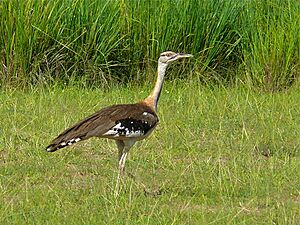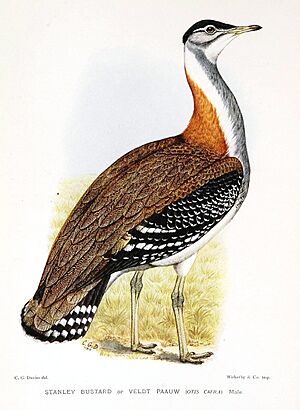Denham's bustard facts for kids
Quick facts for kids Denham's bustard |
|
|---|---|
 |
|
| Conservation status | |
| Scientific classification | |
| Genus: |
Neotis
|
| Species: |
denhami
|
| Synonyms | |
|
Neotis cafra denhami |
|
The Denham's bustard is a very large bird that belongs to the bustard family. It is also known as the Stanley bustard or Stanley's bustard. Its scientific name is Neotis denhami.
These birds live in many parts of Sub-Saharan Africa. They like open areas such as grasslands, farmland, and flood-plains. Some populations that live inland might move to lower areas during winter. The bird's common names honor Major Dixon Denham, an English explorer, and Edward Smith-Stanley, 13th Earl of Derby, an English naturalist.
Contents
What Does It Look Like?
The Denham's bustard is the biggest bird in its group, called Neotis. Male bustards are quite large, weighing about 9 to 10 kilograms (20 to 22 pounds). They can stand 100 to 116 centimeters (39 to 46 inches) tall. Females are smaller, weighing 3 to 4 kilograms (6.6 to 8.8 pounds) and standing 80 to 87 centimeters (31 to 34 inches) tall.
Their backs are brown, and their undersides are white. They have a pale grey neck with an orange patch on the back of the head. A black border surrounds their grey crown. A black line also runs through their eye, with a white line above it like an eyebrow. Their long legs are pale yellow, and their beak is a whitish color.
When a male Denham's bustard wants to impress a female, he puffs up his throat. This makes a big balloon of white feathers appear. These birds are usually quiet.
Where Do They Live?
There are three different types, or subspecies, of the Denham's bustard. Each type lives in a separate area.
- N. d. denhami lives in places like Mauritania, Senegal, Gambia, Uganda, and Ethiopia.
- N. d. jacksoni is found in Kenya, Tanzania, Zambia, Botswana, Zimbabwe, Angola, and the Democratic Republic of Congo.
- N. d. stanleyi lives in South Africa and Eswatini.
These bustards prefer grasslands and savannas. They can live at high places, up to 3,000 meters (9,800 feet) above sea level. They can also be found in other areas like dense shrubland, light woodland, farmland, and dry marshes.
How Do They Behave?
Denham's bustards often live alone when it's not mating season. However, they might gather in groups if there's a lot of food. They also travel together during migrations, usually to find new food sources after it rains.
These birds are omnivores, meaning they eat both plants and animals. They eat many different things depending on what's available. Their diet includes insects, small snakes, rodents, and even baby birds from other nests. They also eat various green plants. Sometimes, they follow large animals like ungulates (hoofed animals) to pick dung beetles from their droppings.
Mating and Nests
Like all bustards, the male Denham's bustard performs a special dance to attract females. This dance happens in a specific area called a lek. During his display, the male puffs up his head and chest. He also flares his tail to look bigger. While doing this, he calls loudly and struts around.
They can breed at different times of the year, especially in East Africa. Breeding often starts when it rains. The female makes a simple nest, which is just a shallow dip in the ground. She lays one or two eggs. If the eggs hatch, she raises the young birds all by herself.
Why Are They Important?
The number of Denham's bustards has been decreasing in many areas where they live. Countries like South Africa, Kenya, and Nigeria have seen a big drop in their populations.
One main reason for this decline is hunting, especially in parts of Sahel and West Africa. In eastern and southern Africa, a bigger problem is that grasslands are being turned into farmland. This means the bustards lose their natural homes. In some places, grasslands are also being turned into forests for logging, which further threatens these birds.



